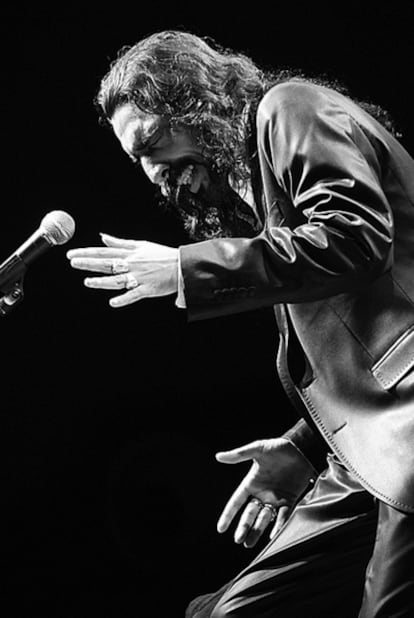'Langoustine' life through a lens
Hefty new book collects intimate images of singer Diego El Cigala
"In a hundred years, when villagers in any part of the world look at this photo book, they will understand Diego's art," says the singer Andrés Calamaro about a new collection of pictures of Diego el Cigala, a flamenco singer best known to foreign audiences for his 2004 album Lágrimas negras, recorded with the Cuban pianist Bebo Valdés.
The photographs are by the German reporter Anya Bartels-Suermondt, who became the shadow of a man with "a voice like caramel, who spills his heart over anything he sings," in the words of the great guitarist Paco de Lucía. For over a year, Bartels-Suermondt followed the popular cantaor on European and American tours, inside dressing rooms and bathrooms, on the street, alone and with his band.
The result of this constant monitoring is Garganta de arena (or, Throat of sand), a 28.5cm by 36.5cm volume weighing in at four kilograms and containing 400 previously unseen shots of the man who was born Ramón Jiménez Salazar 43 years ago.
The work was presented this week at Madrid's Hotel de las Letras, where the man who goes by the artistic name of El Cigala (literally, the langoustine) admitted that "I never thought that the world of photography could convey so much. I just tried to show myself the way I am, with my faults and my positive points. It was a very nice experience, although Anya always caught me off guard. I could never tell her, 'Wait, let me pose for this'."
The book was born out of another compendium of photographs of the bullfighter José Tomás, also by Bartels-Suermondt. Diego el Cigala, who is a fan of his, said he marveled at the pictures of the matador; meanwhile, Anya has admired the flamenco singer ever since she first heard him sing. A friend introduced them, and El Cigala told her: "Girl, I want you to make me a book just like the one you made for José Tomás."
The photographer talked about a "hand-in-hand" relationship that began with his recording of Dos lágrimas in 2008. While Diego sang classics like Compromiso, the reporter began shooting. Over the next few months she added material from his concerts in Argentina, Mexico and Chile, as well as special performances like the one he gave at a Mallorca penitentiary.
"I told him right from the beginning that if my presence ever bothered him, he could make a sign and I would disappear," said Bartels-Suermondt a few hours before the book presentation. As it turned out, this only happened a couple of times. "Anya, leave me alone for a minute, please," he would say, and call her back soon after that.
There are no captions to the hundreds of photographs in Garganta de arena, which is named after a tango. "I preferred for the images to speak for themselves. They don't follow a chronological order, either. I just wanted to reflect the person's character," added the photographer.
Bartels-Suermondt said that, in person, El Cigala is "naturalness personified. If he is sad, he cries real tears; if it is time to laugh, he laughs his head off. He treats everyone the same, and he's really funny. Because his musical ear is prodigious, he can do great impressions of people."








































